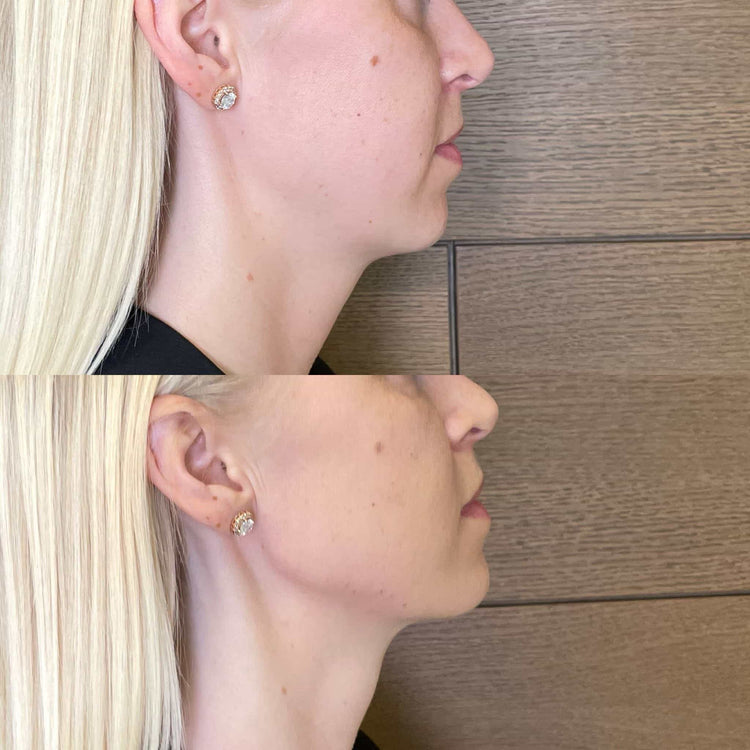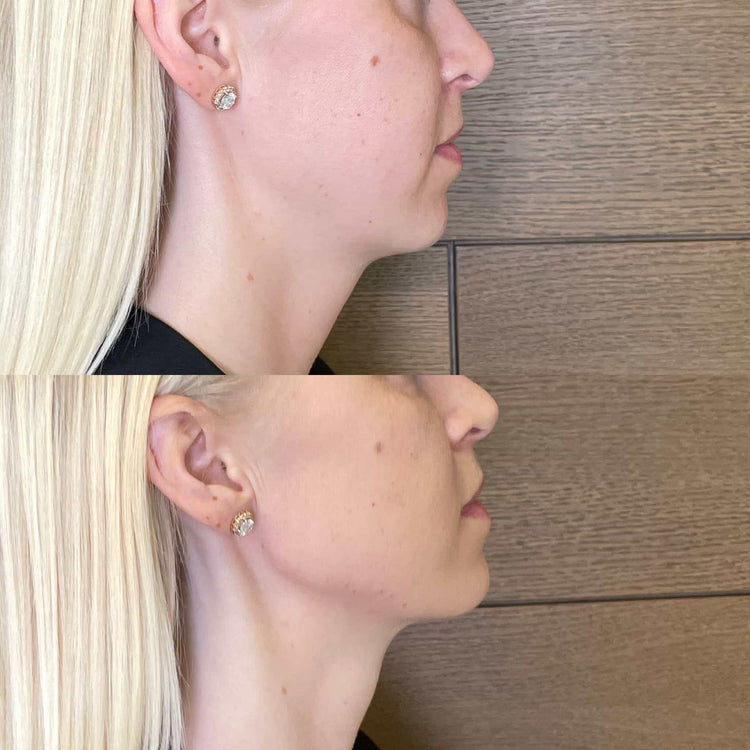The Cannula Technique
The cannula technique is an increasingly popular method for facial filler injections, particularly in the jaw area. Unlike traditional needle-based injections, this technique utilizes a blunt-tipped cannula to deliver dermal fillers, minimizing trauma and maximizing precision.
What is a Cannula?
A cannula is a medical instrument resembling a hollow tube with a rounded or blunted tip. In the context of facial aesthetics, cannulas are specifically designed for the precise placement of dermal fillers. Unlike needles that have sharp points, cannulas lack sharp edges, reducing the risk of bruising, swelling, and other side effects associated with traditional needle injections.
Advantages of the Cannula Technique
The cannula technique offers several advantages over traditional needle-based filler injections, making it a popular choice for jaw augmentation. Firstly, the blunt tip of the cannula reduces the risk of trauma to surrounding tissues, minimizing bruising and swelling. This gentler approach leads to shorter recovery times and less discomfort post-treatment.
Secondly, cannulas allow for more precise placement of filler. Their flexible design enables them to navigate through delicate facial structures with ease, allowing practitioners to achieve a more natural and sculpted look. The controlled delivery of filler minimizes the risk of uneven distribution or lumpiness, resulting in smoother, more aesthetically pleasing outcomes.

Procedure for Jaw Filler Injections Using the Cannula Technique
The cannula technique is an increasingly popular method for facial filler injections, particularly in the jaw area. Unlike traditional needle-based injections, this technique utilizes a blunt-tipped cannula to deliver dermal fillers, minimizing trauma and maximizing precision.
A cannula is a medical instrument resembling a hollow tube with a rounded or blunted tip. In the context of facial aesthetics, cannulas are specifically designed for the precise placement of dermal fillers. Unlike needles that have sharp points, cannulas lack sharp edges, reducing the risk of bruising, swelling, and other side effects associated with traditional needle injections.
The cannula technique offers several advantages over traditional needle-based filler injections, making it a popular choice for jaw augmentation.
- Firstly, the blunt tip of the cannula reduces the risk of trauma to surrounding tissues, minimizing bruising and swelling. This gentler approach leads to shorter recovery times and less discomfort post-treatment.
- Secondly, cannulas allow for more precise placement of filler. Their flexible design enables them to navigate through delicate facial structures with ease, allowing practitioners to achieve a more natural and sculpted look. The controlled delivery of filler minimizes the risk of uneven distribution or lumpiness, resulting in smoother, more aesthetically pleasing outcomes.
Preparation
The cannula technique involves the use of a blunt-tipped cannula to deliver dermal fillers, particularly for jaw augmentation. This method offers several advantages over traditional needle-based injections.

Cannulas are designed with rounded or blunted tips, unlike needles which have sharp points. This difference minimizes trauma to surrounding tissues, leading to reduced bruising and swelling.
The cannula’s flexible design allows for precise placement of filler within delicate facial structures. This precision helps achieve a more natural and sculpted look by minimizing the risk of uneven distribution or lumpiness.
Injection Process
The cannula technique is an increasingly popular method for facial filler injections, particularly in the jaw area. Unlike traditional needle-based injections, this technique utilizes a blunt-tipped cannula to deliver dermal fillers, minimizing trauma and maximizing precision.
A cannula is a medical instrument resembling a hollow tube with a rounded or blunted tip. In the context of facial aesthetics, cannulas are specifically designed for the precise placement of dermal fillers. Unlike needles that have sharp points, cannulas lack sharp edges, reducing the risk of bruising, swelling, and other side effects associated with traditional needle injections.
The cannula technique offers several advantages over traditional needle-based filler injections, making it a popular choice for jaw augmentation. Firstly, the blunt tip of the cannula reduces the risk of trauma to surrounding tissues, minimizing bruising and swelling. This gentler approach leads to shorter recovery times and less discomfort post-treatment.
Secondly, cannulas allow for more precise placement of filler. Their flexible design enables them to navigate through delicate facial structures with ease, allowing practitioners to achieve a more natural and sculpted look. The controlled delivery of filler minimizes the risk of uneven distribution or lumpiness, resulting in smoother, more aesthetically pleasing outcomes.
Aftercare
Aftercare instructions are crucial for optimal results and minimizing potential complications following cannula jaw filler injections.
Patients should avoid touching, massaging, or applying pressure to the treated area for at least 24 hours.
It’s also important to stay hydrated by drinking plenty of water to promote healing and reduce swelling.
Avoid strenuous activities, intense exercise, or exposure to extreme temperatures for a few days following the procedure.
Use cold compresses intermittently during the first 24-48 hours to minimize bruising and inflammation.
Over-the-counter pain relievers can be taken as needed to manage any discomfort.
It’s essential to follow your practitioner’s specific aftercare instructions, attend all scheduled follow-up appointments, and promptly report any unusual symptoms or concerns.
Risks and Side Effects
Like any medical procedure, cannula jaw filler injections carry certain risks and side effects, although they are generally considered safe when performed by a qualified and experienced practitioner.
- Bruising and Swelling: These are the most common side effects and typically resolve within a few days to a week.
- Redness and Tenderness: The treated area may be red and tender for a short period, which usually subsides as the procedure heals.
- Infection: As with any injection, there is a slight risk of infection. It’s important to follow proper hygiene practices and aftercare instructions to minimize this risk.
- Asymmetry: Although cannula technique aims for precision, some asymmetry may occur. This can often be addressed during follow-up appointments with adjustments.
- Lumps or Nodules: In rare cases, lumps or nodules may form at the injection site. These usually resolve over time but may require additional treatment.
Recovery Time
Recovery time after cannula jaw filler injections is typically shorter compared to traditional needle-based injections. Most individuals experience minimal bruising and swelling, which usually subside within a few days.
Patients can generally resume their normal activities within a day or two after the procedure.
Strenuous exercise, intense heat exposure, and massage should be avoided for at least a few days to allow the area to heal properly.
Benefits of the Cannula Technique for Jaw Fillers
The cannula technique offers several advantages over traditional needle-based filler injections, making it a popular choice for jaw augmentation. Firstly, the blunt tip of the cannula reduces the risk of trauma to surrounding tissues, minimizing bruising and swelling. This gentler approach leads to shorter recovery times and less discomfort post-treatment.
Secondly, cannulas allow for more precise placement of filler. Their flexible design enables them to navigate through delicate facial structures with ease, allowing practitioners to achieve a more natural and sculpted look. The controlled delivery of filler minimizes the risk of uneven distribution or lumpiness, resulting in smoother, more aesthetically pleasing outcomes.
When to Consider Jaw Filler Injections with the Cannula Technique
Consider jaw filler injections with the cannula technique when you desire subtle or noticeable contouring of your jawline for a more defined and balanced facial appearance.
If you have concerns about excessive jowls, a weak or undefined chin, or asymmetry in the lower face, this treatment may be suitable.
Individuals seeking to enhance their facial profile or achieve a more youthful look by addressing age-related changes in jawline definition can also benefit from this technique.
Get a sharper jawline with jaw filler treatments from Dr. Laura Geige at It’s Me & You Clinic
- Why Am I Losing So Much Hair At My Temples? - November 10, 2025
- What Is Sexual Nonconformity And How Does It Challenge Heteronormative Standards? - November 9, 2025
- Weed Infused Drinks That Help You Focus - November 8, 2025